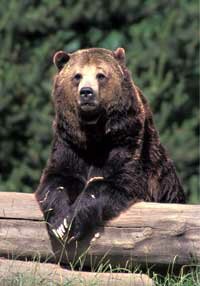 Grizzly Bear Grizzly Bear
scientific name
Ursus arctos horribilis
size/weight/height
Head/Tail Length: 9'
Shoulder Height: 3-4'
Weight: 300-850 lbs.
(size notably related to available food)
Adaptations/Coloration
Color: extremely variable - cream, cinnamon, brown to almost black; fur bleaches in sun
Body: large; heavily built
Claws: non-retractile; for digging tubers, burrowing rodents & stripping branches
Ears: small
Eyes: small
Fur: thick, good insulation
Head: massive
Hearing: moderate
Jaws: powerful
Limbs: powerful
Smell: excellent
Snout: large
Speed: maximum 30 mph ( fast as a deer)
Teeth: flattened cheek teeth; piercing canines
Vision: poor
behavior
Hibernation: bears not classified as hibernators
Territory: marked by scraping bark from tree & rubbing against leaving scent
Winter: enter dormancy period; body temperature/pulse doesn't drop; doesn't eat (lives off fat built-up during fall); reasons - chiefly food (succulent vegetation) not available
adult males solitary with range encompassing several adult females' ranges;
males reduce potential competition by evicting (even killing) sub-adult males; females vigorously defend young
reproduction/life span
Life span: wild 25-30 yrs., captivity maximum 47 yrs. (documented)
Mature: 6-8 yrs.
Breed: May-June
Implantation: delayed until Oct-Nov when female dens
Gestation: 210-255 days
Birth Interval: 3-5 years; dependent on available food
Litter: 2-3
Cubs: weigh 12-14 oz; can't regulate body temperature; remain with mom 1-4 years
Den: snug environment providing warmth; leave den April to June
Reproduction Activity: (female 1st birth, litter size, birth interval) controlled by nutritional factors
diet
omnivore
Wild: almost anything; includes succulent vegetation, tubers, berries, insect grubs, small rodents, salmon, trout, carrion, young hoofed mammals (deer, etc.), & livestock if opportunity arises; eats 26-35 lbs. daily
Zoo: omnivore chow, carrots, apples, herring, & bone 1 day/week
habitat/range
chiefly mountainous forests, NW North America, especially Alaska, Idaho, Wyoming, Montana, & Yellowstone National Park
status
U.S. Threatened, CITES App II
other
there may be serious problems with bears coexisting with humans, even in parks & wildlife areas
oregon zoo exhibit
Alaska Tundra
back to top
|


